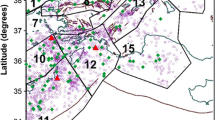Abstract
The logical tree methods are used for evaluate quantitatively relationship between frequency and magnitude, and deduce uncertainties of annual occurrence rate of earthquakes in the periods of lower magnitude earthquake. The uncertainties include deviations from the self-similarity of frequency-magnitude relations, different fitting methods, different methods obtained the annual occurrence rate, magnitude step used in fitting, start magnitude, error of magnitude and so on. Taking Xianshuihe River source zone as an example, we analyze uncertainties of occurrence rate of earthquakes M ≥ 4, which is needed in risk evaluation extrapolating from frequency-magnitude relations of stronger earthquakes. The annual occurrence rate of M ≥ 4 is usually required for seismic hazard assessment.
The sensitivity analysis and examinations indicate that, in the same frequency-magnitude relations fitting method, the most sensitive factor is annual occurrence rate, the second is magnitude step and the following is start magnitude. Effect of magnitude error is rather small.
Procedure of estimating the uncertainties is as follows: (1) Establishing a logical tree described uncertainties in frequency-magnitude relations by available data and knowledge about studied region. (2) Calculating frequency-magnitude relations for each end branches. (3) Examining sensitivities of each uncertainty factors, amending structure of logical tree and adjusting original weights. (4) Recalculating frequency-magnitude relations of end branches and complementary cumulative distribution function (CCDF) in each magnitude intervals. (5) Obtaining an annual occurrence rate of M ≥ 4 earthquakes under given fractiles.
Taking fractiles as 20% and 80%, annual occurrence rate of M ≥ 4 events in Xianshuihe seismic zone is 0.643 0. The annual occurrence rate is 0.631 8 under fractiles of 50%, which is very close to that under fractiles 20% and 80%.
Similar content being viewed by others
References
Aki K, 1987. Magnitude-frequency relation for small earthquakes: a clue to the origin of f max of large earthquakes. J Geophys Res, 92: 1 349–1 355
Carlson J M, 1991. Time intervals between characteristic earthquakes and correlation with smaller events: an analysis based on a mechanical model of a fault. J Geophys Res, 96: 4 255–4 267
Coppersmith K J, 1986. Capturing uncertainty in probabilistic seismic hazard assessment within intraplate tectonic environments. In: Proceedings of the 3rd Unite State Conference on Earthquake Engineering. Charleston, South Carolina, 1: 301–312
Gutenberg B and Richter C F, 1944. Frequency of earthquakes in California. Bull Seism Soc Amer, 34: 185–188
Kulkarni, R B, Youngs R R and Copersmith K J, 1984. Assessment of confidence intervals for results of seismic hazard analysis. In: Proceedings of the 8th World Conference on Earthquake Engineering. Englewood Cliffs, New Jersey, 1: 263–270
McQuire R K, 1977. Effects of uncertainty in seismicity on estimates of seismic hazard for the east coast of the United States. Bull Seism Soc Amer, 67: 827–848
McQuire R K, 1990. Demonstrations of a risk-based approach to high-level waste repository evaluations. EPRI, NP-7057, 9.1–9.16
McQuire R K, 1996. FRISK88M: User’s manual. Colorado 80303 USA: Risk Engineering Inc
Pacheco J T, Schols C H and Sykes L R, 1992. Changes in frequency-size relationship from small to large earthquakes. Nature, 355: 71–73
Papadopoulos G A, Skafida H G and Vassiliou I T, 1993. Nonlinearity of the magnitude-frequency relation in the Hellenic Arc-Trench system and the characteristic earthquake model. J Geophys Res, 98: 17 737–17 744
Radulian M, Trifu C I and Carbunar F O, 1991. Numerical simulation of the earthquake generation process. PAGEOPH, 136: 499–514
Rydelek P A and Sacks I S, 1989. Testing the completeness of earthquake catalogues and the hypothesis of self-similarity. Nature, 337: 251–253
Taylor D W A, Snock J A and Takanami T, 1990. Nonlinear frequency-magnitude relationships for the Hokkaido Corner, Japan. Bull Seism Soc Amer, 80(2): 340–353
Umino N and Sacks I S, 1993. Magnitude-frequency relation for northeastern Japan. Bull Seism Soc Amer, 83: 1 492–1 506
Weichert D H, 1980. Estimation on the earthquake recurrence parameters for unequal observation periods for different magnitude. Bull Seism Soc Amer, 70: 1 337–1 346
Author information
Authors and Affiliations
About this article
Cite this article
Yang, ZX., Zhang, PZ. & Zheng, YJ. Uncertainities in estimation of extrapolated annual occurrence rate of earthquakes using logical tree. Acta Seimol. Sin. 11, 219–228 (1998). https://doi.org/10.1007/s11589-998-0059-x
Received:
Revised:
Accepted:
Issue Date:
DOI: https://doi.org/10.1007/s11589-998-0059-x




